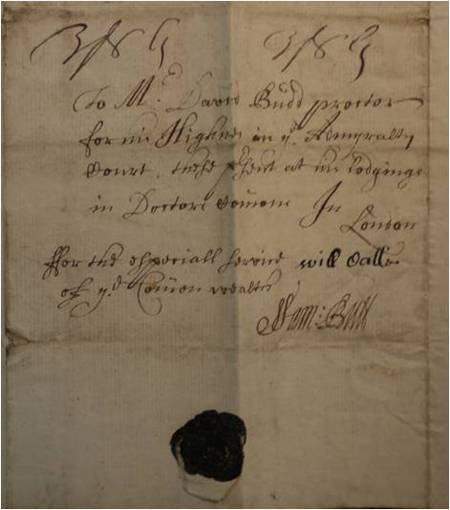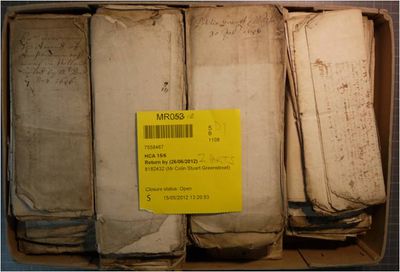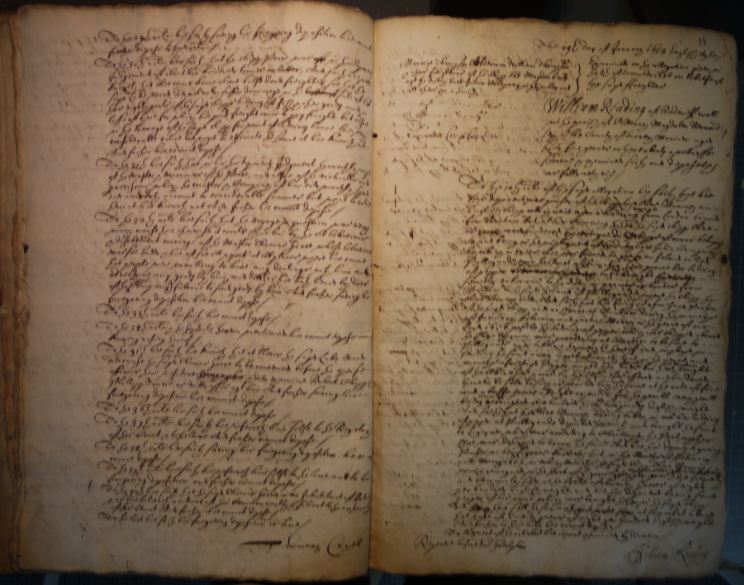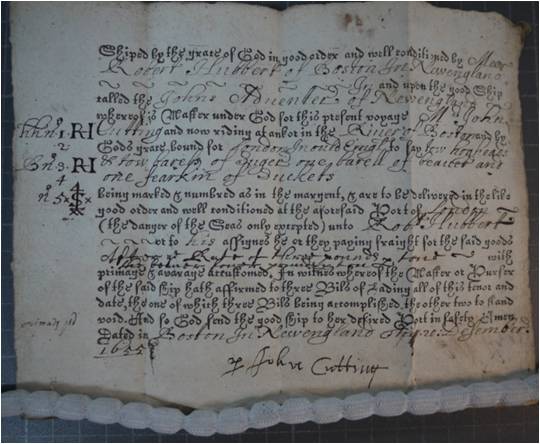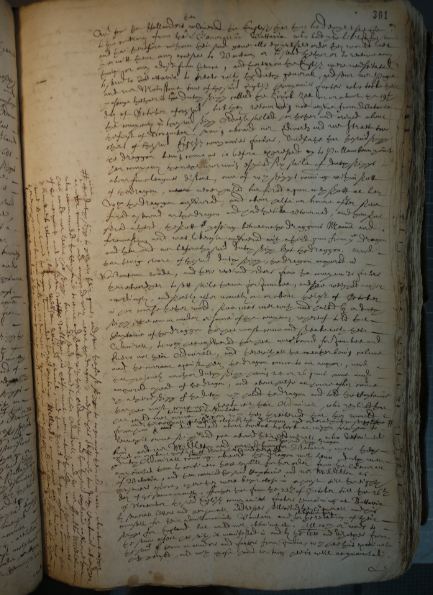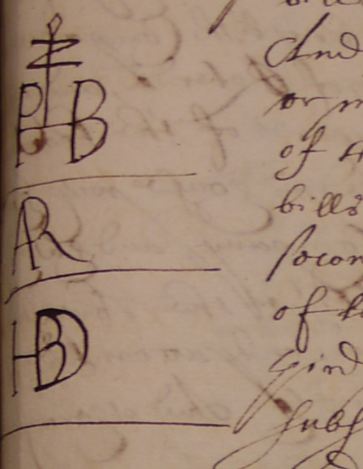Difference between revisions of "Introduction to the High Court of Admiralty"
| Line 185: | Line 185: | ||
===Double page spreads=== | ===Double page spreads=== | ||
| − | [ | + | * Typical volumes have text on both sides of paper pages |
| + | * Folio numbers are typically to be found on the top right hand side of the right hand page. These right hand pages are described as "recto" | ||
| + | * Left hand pages do not bear folio numbers, and are described as "verso" | ||
| + | |||
| + | <u>Illustration: Open volume showing left and right hand pages, HCA 13/73 f. 14v & f. 15r</u> | ||
| + | |||
| + | [[File:EXTRACT_HCA_1373_f14v_f15r_Double_Page_P1110299_130812.JPG]] | ||
| + | |||
---- | ---- | ||
| − | === | + | ===Typical single leaf layout=== |
| + | |||
| + | [ADD ILLUSTRATION] | ||
---- | ---- | ||
| − | ====Summary case details==== | + | ====Single leaf layout detail: Summary case details==== |
<u>Illustration: Clayme of Domingo Centurione, HCA 13/68 f.305v</u> | <u>Illustration: Clayme of Domingo Centurione, HCA 13/68 f.305v</u> | ||
| Line 195: | Line 204: | ||
[[File:SNIPPET_Clayme_Domingo_Centurione_HCA_1368_P1110236_f305v.JPG|thumbnail|700px|none]] | [[File:SNIPPET_Clayme_Domingo_Centurione_HCA_1368_P1110236_f305v.JPG|thumbnail|700px|none]] | ||
---- | ---- | ||
| − | ====Fuller case details==== | + | ====Single leaf layout detail: Fuller case details==== |
<u>Illustration: Parliament vs. the Golden Starr, HCA 13/68 f.1r</u> | <u>Illustration: Parliament vs. the Golden Starr, HCA 13/68 f.1r</u> | ||
| Line 201: | Line 210: | ||
[[File:SNIPPET_Parliament_agt_Golden_Starr_Layout_Startcase_HCA_1368_f1r.JPG|thumbnail|700px|none]] | [[File:SNIPPET_Parliament_agt_Golden_Starr_Layout_Startcase_HCA_1368_f1r.JPG|thumbnail|700px|none]] | ||
---- | ---- | ||
| − | ====Page bottom==== | + | ====Single leaf layout detail: Page bottom==== |
<u>Illustration: XXXX, HCA 13/68 f.164v</u> | <u>Illustration: XXXX, HCA 13/68 f.164v</u> | ||
[[File:SNIPPET_Page_Bottom_Runover_HCA1368_f164v_120812.JPG|thumbnail|700px|none]] | [[File:SNIPPET_Page_Bottom_Runover_HCA1368_f164v_120812.JPG|thumbnail|700px|none]] | ||
| − | |||
| − | |||
| − | |||
| − | |||
---- | ---- | ||
===Handwriting=== | ===Handwriting=== | ||
| Line 232: | Line 237: | ||
[[File:EXTRACT_P1120107.JPG|thumbnail|700px|none]] | [[File:EXTRACT_P1120107.JPG|thumbnail|700px|none]] | ||
| + | ---- | ||
| + | ====Signatures==== | ||
| + | |||
| + | * Signatures can be wonderfully flamboyant | ||
| + | * A surprising number of common seamen were sufficiently literate to sign their names | ||
| + | |||
| + | <u>Illustration: Signatures of John Shorter, XXXX, and William Warren, HCA 13/129, no folio no., recto</u> | ||
| + | |||
| + | [[File:EXTRACT_HCA_13129_P1110007_130812.JPG|thumbnail|400px|none]] | ||
| + | |||
| + | <u>Illustration: The marke of Henrick Williamson, HCA XX/XX, XX</u> | ||
| − | [ | + | [[File:EXTRACT_HCA_XXXX_f_Marke_Of_Henrick_Williamson_130812.jpg|thumbnail|400px|none]] |
---- | ---- | ||
====Mixed printed text and non-legal hand==== | ====Mixed printed text and non-legal hand==== | ||
| Line 262: | Line 278: | ||
===Marginalia=== | ===Marginalia=== | ||
---- | ---- | ||
| − | ====Text marginalia==== | + | ====Text marginalia: Block of text==== |
| + | |||
| + | <u>Illustration: Block of text at 90 degrees in LH margin of RH page, HCA 13/73 f. 301r: XXXX</u> | ||
| + | |||
| + | [[File:EXTRACT_HCA_1373_f301r_P1110412_130812.JPG|thumbnail|400px|none]] | ||
| + | ---- | ||
| + | ====Text marginalia: Abbreviation==== | ||
| + | |||
| + | <u>Illustration: Text abbreviation in LH margin at start of an examination on an allegation, Xth March 1658/59, HCA 13/73 f. 52r</u> | ||
| − | [ | + | [[File:EXTRACT_HCA_1373_f52r_P1110306_130812_SmallVer.JPG|thumbnail|700px|none]] |
---- | ---- | ||
====Merchants marks==== | ====Merchants marks==== | ||
| Line 270: | Line 294: | ||
<u>Example: Merchants Marks in LH margin, HCA 13/68 f. 304r</u> | <u>Example: Merchants Marks in LH margin, HCA 13/68 f. 304r</u> | ||
| − | [[File:SNIPPET_HCA_1368_MerchantsMarks_P1110234_f304.JPG|thumbnail| | + | [[File:SNIPPET_HCA_1368_MerchantsMarks_P1110234_f304.JPG|thumbnail|400px|none]] |
---- | ---- | ||
==What records of the Admiralty Court are at the National Archives?== | ==What records of the Admiralty Court are at the National Archives?== | ||
Revision as of 22:34, August 13, 2012
Introduction to the High Court of Admiralty
Editorial history
11/08/12: CSG, created page
Purpose of this page
To provide an introduction to the C17th High Court of Admiralty in London
Contents
- 1 What was the High Court of Admiralty?
- 2 The language and procedures of Admiralty Court
- 3 The records of the Admiralty Court
- 4 What do the records of the Admiralty Court look like?
- 5 What records of the Admiralty Court are at the National Archives?
- 6 Sample transcriptions, 1650-1669
- 7 Historiography
- 8 Suggested reading
What was the High Court of Admiralty?
- When was the Court established?
- The High Court of Admiralty was established in the 1320 to deal primarily with questions of piracy or spoil
- What was its jurisdiction?
- Over time its jurisdiction developed to cover prize and civil jurisdiction in such matters as salvage and collision
- Actions could be taken against ships and goods as well as against persons
- After the restoration (of the monarchy) in 1660, the civil business of the court divided, with an instance court and a prize court
- Who were the judges?
- The judges were doctors of civil law, who had studied at either Oxford or Cambridge
- Their legal training differed from that of lawyers practising the common law, who were admitted to Inns of Court in Holborn
- The judges of the High Court of Admiralty held court sessions at Doctors Commons, which before the London fire of 1666 was located in the parish of St Paul Bennetts wharf
Text extract: Obligation compelling George Walters to appear at Doctors Commons before the Judges of the High Court of Admiralty, March 2nd, 1656
"The Condition of This Obligacon is such That If the
Above bounden George Walters shall be and Appeare before
The Lord Protector of The Commonwealth of England x:r
the Judges of the high Court of Admyralty of England
At the Commons hall wthin y:e Doctors Commons Scituate in
The parish of Sainct Benedict neare Pauls Wharfe London
The Tenth day After the date hereof if it be Court day
or Else The next Court followinge At The usuall houres
for hearinge of Causes, To Answer unto Thomas Skinner
in A Cause Civill & Marine, And shall not departe from
-thence, without Leave, And Licence of the Court That
Then this obligacon to be void & of non Effect
Otherwayes to stand in full force power & vertue"[1]
- Several other types of legal official and lawyer attended the sessions of the High Court of Admiralty. These included proctors, public notaries, clerks, and legal counsel for the parties concerned
Illustration: Document wrapper addressed to M:r David Budd, proctor for his Highnes in y:e Admyralty Court, HCA 15/6 Box Two, ca. 1658
- Who were the protagonists in legal disputes?
Plaintiffs: XXXX
Defendants: XXXX
Witnesses: XXXX
Legal counsel: XXXX
The language and procedures of Admiralty Court
- English, with a little latin
- What latin will you find, and how can you read it?
Common Latin Phrases
- English legal and commercial language
Legal Terms
The records of the Admiralty Court
- Why were records kept?
- Who kept the records?
Allegations
- What is an allegation?
- An example: XXXX
Answers
- What is an answer?
- An example: XXXX
Examinations
- What is an examination?
- An example: XXXX
Interrogatories
- What is an interrogatory?
- An Interrogatory is a pre-prepared list of questions to be put to deponents by the proctors of the High Court of Admiralty
- An interrogatory consists of numbered questions which are primarily English, though often introduced with Latin phrases
- Such interrogatories can be found in bound leather volumes in the HCA 23 record series, for example HCA 23/19 (1658-1664)
Illustration: Loose foldover front leather cover with clasp, HCA 23/19 (1658-1664)
- Example from HCA 23/19
- Example: Introduction & first question from Interrogatories in behalf of John Absolun[2]
"Interrogatoryes on the behalfe of John Absolon
to be administered to whatever prdsed wutnesses
produced or to bee produced on the behalfe of
Nicholas Payne as followeth,
1 Imprimis Interrogot:r quilet testis to what shippe hee belonged
and how hee commeth to be a witnes in this cause whether
hee doth not well know that the Shipp the Swanne of
which the said Absolon was master commeing from New-
castle upon or about the seaventeenth of may last 1660
about 10 or 11 of the clock in the morneing sett saile
from or neare Newcastle with her ladeing of coales
and whether the shippe the Prospous (sic) of Bright Hampton
did not follow next after the Swanne and y:t they turned
about the bill poynt, Whether the Prospous had not
the greater wynd & did becalme the Swanne & whether
the Maste or some other of the Company of the Swanne
did not call out to the company of the Prosperous to
loare (sic) theire top sailes or else they would come
foule of them, & whether some of y:e Prosperous did not
heare & make answeare that they would warrant that
they would bee foule of them or to that effect, or what
did they say, And let each bee asked joyntly sewally
and of each particular,"
Illustration: Text on recto, no text on verso, fastened by tie in top LH corner, HCA 23/19, unfoliated (1658-1664)
Further single question examples from HCA 23/19
"4. Itmm: interr. When had the Claymers or the wittnesse first
Notice that the shippe Nativity was stayed neere ffalmouth..."[3]
"1 Imprimis Interrogot:r quilet testis to what shippe hee belonged
and how hee commeth to be a witnes in this cause..."[4]
Schedules
- What is a schedule?
- Schedules of information are occasionally referred to in individual answers or in individual examinations
- Often these schedules are not included in the volume containing the answers or examinations
- Occasionally these schedules can be found in boxes of loose documents (usually unfoliated), such as HCA 15/6 Box One 1654-1657, and HCA 15/6 Box Two 1654-1657
What do the records of the Admiralty Court look like?
Leather bindings
- Most of the HCA record series consist of paper manuscript pages, which have been collated into volumes and been stitched into large leather bindings. Pages are usually, but not always, in chronological order. Presumably errors in chronology occured during the collation process. Most of the bindings from the period 1650-1669 are original.
Illustration: Front leather cover of bound volume, HCA 13/68, 1653/54
- The record series HCA 15/6 is an exception, and consists of loose, boxed documents. A greater variety of handwriting is to be found in these documents, since many are the products of non-legal hands, and since the document types are very diverse. They include bills of lading, bonds, charter parties, financial accounts of voyages, inventories, letters, and petitions.
Illustration: HCA 15/6, second of two boxes of loose documents
Double page spreads
- Typical volumes have text on both sides of paper pages
- Folio numbers are typically to be found on the top right hand side of the right hand page. These right hand pages are described as "recto"
- Left hand pages do not bear folio numbers, and are described as "verso"
Illustration: Open volume showing left and right hand pages, HCA 13/73 f. 14v & f. 15r
Typical single leaf layout
[ADD ILLUSTRATION]
Single leaf layout detail: Summary case details
Illustration: Clayme of Domingo Centurione, HCA 13/68 f.305v
Single leaf layout detail: Fuller case details
Illustration: Parliament vs. the Golden Starr, HCA 13/68 f.1r
Single leaf layout detail: Page bottom
Illustration: XXXX, HCA 13/68 f.164v
Handwriting
Very clear italic hand
Illustration: XXXX
Very clear formal italic hand
Illustration: XXXX
Flowing italic hand
Illustration: XXXX
See [Transcription]
Signatures
- Signatures can be wonderfully flamboyant
- A surprising number of common seamen were sufficiently literate to sign their names
Illustration: Signatures of John Shorter, XXXX, and William Warren, HCA 13/129, no folio no., recto
Illustration: The marke of Henrick Williamson, HCA XX/XX, XX
Mixed printed text and non-legal hand
Illustration: Bill of lading, dated Dec. 20th, 1655, HCA 15/6 Box Two, no folio no.
See Transcription
Punctuation
[ADD EXAMPLES]
Spacing
[ADD EXAMPLES]
Deletions and interpolations
Line through text
Illustration: From deposition of George Dethwick, merchant of London, aged thirty yeeres or thereabouts, dated Jan. 24th 1658/59, HCA 13/73, no folio no.
[ADD EXAMPLE OF INTERPOLATIONS]
Marginalia
Text marginalia: Block of text
Illustration: Block of text at 90 degrees in LH margin of RH page, HCA 13/73 f. 301r: XXXX
Text marginalia: Abbreviation
Illustration: Text abbreviation in LH margin at start of an examination on an allegation, Xth March 1658/59, HCA 13/73 f. 52r
Merchants marks
Example: Merchants Marks in LH margin, HCA 13/68 f. 304r
What records of the Admiralty Court are at the National Archives?
- What records are in Kew?
- The National Archives at Kew contains the extensive records of the High Court of Admiralty from as early as 1536 until 1859
- An index of the mid-C17th High Court of Admiralty record series has been prepared for the project team. See TNA index, 1650-1669
- How did they get there?
- How can you see them?
- The records of the High Court of Admiralty can be viewed in the Large Manuscripts and Maps Room on the second floor of the National Archives at Kew
- You will need a reader's ticket, which can be obtained on the day of your visit. You will need to take two valid pieces of identification with you - one with a recent photograph of you, and the other with your home address and of a recent date. See Obtaining a Reader's ticket
- HCA manuscripts can be ordered at any terminal in the Large Manuscripts and Maps Room, and may take between thirty and sixty minutes to be produced from storage
- The National Archives are closed on Sundays and Mondays, but are open Tuesday through Saturday, with late opening on Tuesday and Thursday. See TNA Opening Times
Sample transcriptions, 1650-1669
Overview of HCA material, 1650-1669
HCA 13/68: Sample images: untranscribed
HCA 13/68: Sample images: draft transcriptions available
Historiography
[DEVELOP THIS SECTION]
Suggested reading
Appleby, John C. (ed.), A Calendar of material relating to Ireland from the High Court of Admiralty Examinations, 1536-1641 (Irish Manuscripts Commission, 1992)
Murphy, Elaine (ed.), A calendar of material relating to Ireland from the High Court of Admiralty, 1641-1660 (Irish Manuscripts Commission, Dublin, 2011)
Senior, W., Doctors Commons and the old court of admiralty (London, 1922)
- Internet Archive online edition
Shilton, Dorothy O. and Richard Holworthy, High Court of Admiralty Examinations, 1637-1638 (London, 1932)
Snell, Steven L., Courts of admiralty and the common law: origins of the American experiment in concurrent jurisdiction (Carolina Academic Press, 2007)
Steckley, George F., 'Collisions, Prohibitions, and the Admiralty Court in Seventeenth-Century London,' Law and History Review, Spring 2003, viewed 10 Nov. 2011
Steckley, George F., 'Instance cases at admiralty in 1657: A court "packed up with sutors"', The Journal of Legal History, vol. 7, issue 1, 1986, pp. 68-83- ↑ HCA 15/6: Item: Bond George Walters, of the Middle Temple, London Esq:r and Thomas Walker of Camberwell, Surrey: Date: March 2nd 1656 (57) no f.
- ↑ HCA 23/19: Document Number: 6: Case: XXXX: Date: XXXX: P1100666 no f., verso
- ↑ HCA 23/19: Document Number: 4: Case: XXXX: Date: XXXX
- ↑ HCA 23/19: Document Number: 6: Case: XXXX: Date: XXXX
